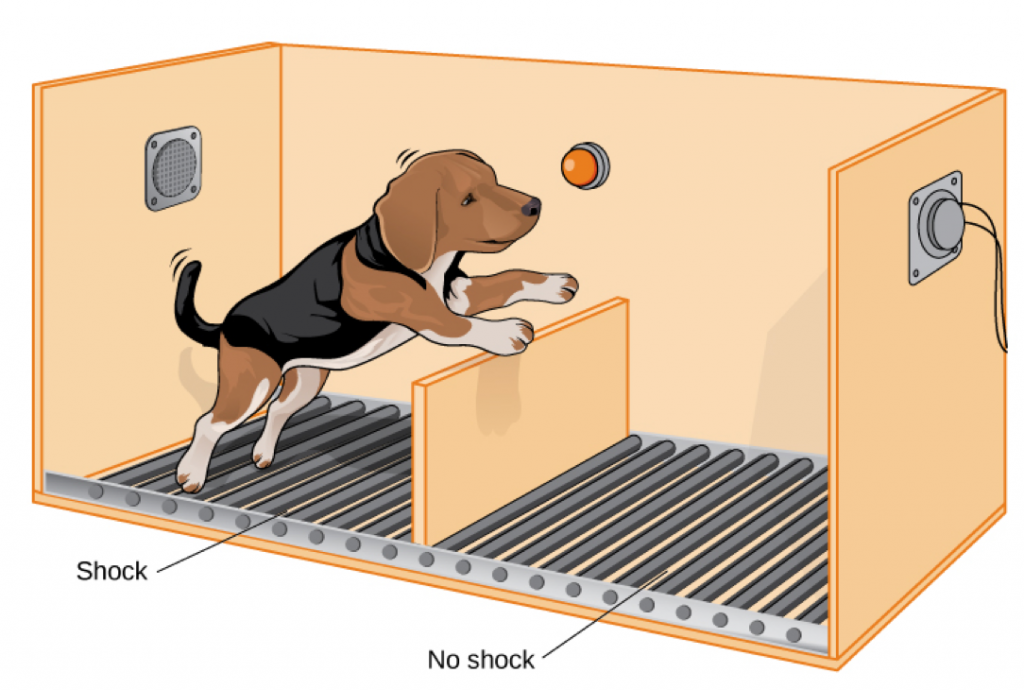You Can’t Win. Don’t Even Try!
by James Corbett
corbettreport.com
March 27, 2021
Imagine you find a prisoner in an unlocked jail cell. Confused, you ask him why he's sitting there when the door to his cell isn't even locked.
"Oh, it's unlocked? I didn't check."
You assure him it's unlocked and ask again why he doesn't leave.
"Why bother? They'll probably catch me before I get out."
You look around in confusion. You explain to him that this isn't even a prison. That he's simply been told to wear an orange jumpsuit and stay in an unlocked room, but he doesn't have to comply. All he has to do is leave.
"Even if I get away, they'll just find me and bring me back here. Might as well just stay put."
Do you think this story is ridiculous? Of course it is. But the situation it details is all too true. In fact, researchers have known for half a century the mechanism by which people can be made to effectively lock themselves up inside their own mental prison . . . and it didn't take long for the intelligence agencies to put that research to use.
Today, let's explore the startling true story of how and how the public has been conditioned into a (false) sense of helplessness, and—more important by far—what you can do to break that conditioning.
LEARNED HELPLESSNESS

If the story of the prisoner who won't escape his unlocked jail cell sounds outlandish, consider the story of The Elephant and the Rope. Short story even shorter:
In India, elephant handlers often train baby elephants to be submissive by chaining them to a post. They’ll fight with all their will to break free. Day in and day out they’ll try, but eventually they just give up. When the baby elephants become adults they no longer need chains to be tied in place; just a thin rope will do.
Now, if that sounds like a cruel thing to do to an elephant, you're right. But it's also effective. Massive, powerful adult elephants can be kept in place with a flimsy rope simply because they have been conditioned since birth to believe that they can't break free of their tether.
But like many things that are obvious to those who work with the natural world, this insight had to be "rediscovered" in the lab by some graduate students in psychology. In this case, Martin Seligman, a psychologist at the University of Pennsylvania, conducted a series of experiments in the late 1960s that essentially replicated this elephant and the rope phenomenon.
Entitled "Learned Helplessness," his 1972 paper outlining this research showed how Seligman and his team had subjected two sets of dogs to painful electric shocks.
The first group of dogs —were placed in a "shuttle box" where they could escape the electric shocks by jumping over a small barrier. These dogs soon learned that crossing the barrier protected them from the shocks and (as you would expect) crossed the barrier more and more quickly each time the experiment was performed until they could escape the shocks altogether.
The second group of dogs were placed in what Seligman described as a "Pavlovian hammock" from which they could not escape the shocks however much they struggled. This set of dogs reacted completely differently from the control group when placed in the shuttle box. Fully two-thirds of this group did not even try to escape the shocks and thus never discovered that they could avoid them altogether by crossing the barrier. They simply lay down, whining, until the shocks ceased.
The lesson of this experiment is seemingly straightforward: "By our hypothesis, the dog does not try to escape because he expects that no instrumental response will produce shock termination." In other words, if you want to induce complete helplessness in a dog, condition them to believe that nothing they do will make any difference.
But, as I noted in my video on Mouse Utopia and the Blackest Pill, animal experiments are never really about animals. They're about humans. In this case, too, the point was not to learn how to induce helplessness in dogs, but to learn how that state of helplessness (aka depression) is induced in humans.
So how long do you think it took for the CIA to start weaponizing Seligman's research for use against its enemies? If your answer was "three decades," then you win a prize!
Yes, by the time the war (of) terror came along, the Criminals In Action were using Seligman's experiments as a how-to guide in their illegal torture program.
ALONG COMES THE CIA

An old folk tale holds that you can conjure the apparition of Mary Bloodsworth (aka "Bloody Mary") by chanting her name in front of a mirror in a candle-lit room. But if you want to summon a real demon, it's much more straightforward than that. All you have to do is document a psychological phenomenon that can be weaponized against the population and before you know it you'll have the CIA at your doorstep, notepad in hand. Just ask Martin Seligman.
Having long since shifted his focus from torturing animals in the name of understanding human depression, by 2001 Seligman had pioneered a new branch of cognitive psychology called positive psychology seeking to help people overcome their learned helplessness (more on which later). As part of that work, Seligman delivered a lecture on at the San Diego Naval Base in May, 2002 on how his research could help American personnel—in his own words—"resist torture and evade successful interrogation by their captors."
Among the hundred or so people in attendance at that lecture was one particularly enthused fan of Selgiman's work: Dr. Jim Mitchell, a military retiree and psychologist who had contracted to provide training services to the CIA. Although Seligman had no idea of it at the time, Mitchell was—as we now know—one of the key architects of the CIA's illegal torture program.
Naturally, Mitchell's interest in Seligman's talk was not in how it could be applied to help American personnel overcome learned helplessness and resist torture but rather how it could be used to induce learned helplessness in a CIA target and enhance torture. As the New York Times described in a report on the subject in 2009:
Dr. Mitchell, colleagues said, believed that producing learned helplessness in a Qaeda interrogation subject might ensure that he would comply with his captor’s demands. Many experienced interrogators disagreed, asserting that a prisoner so demoralized would say whatever he thought the interrogator expected.
Unsurprisingly, Mitchell got his way and, equally unsurprisingly, those submitted to these techniques began to say whatever their interrogators expected, exactly as predicted. Mitchell and his colleague, Dr. Bruce Jessen, helped direct the 2002 "interrogation" of Abu Zubaydah—who was waterboarded 83 times in a single month—and the supposed 9/11 "mastermind," Khalid Sheikh Mohammed, who "confessed" to the 9/11 plot after being waterboarded 183 times and sleep deprived for over six days. Mitchell himself even personally threatened to cut the throat of KSM's son during one interrogation.
These techniques were so effective that, not only did they produce the testimony that formed the backbone of the 9/11 Commission Report (and thus, to this day form the backbone of the official 9/11 story), they also caused KSM to confess to targeting a bank that wasn't even founded until after his arrest! Talk about results!
In a sick way, the CIA's experiments in inducing learned helplessness proved that Seligman had discovered valid insights into a real psychological phenomenon. It certainly is possible to create the conditions to break someone's will and cause them to confess to whatever their torturers want. But this is emphatically not the point of the learned helplessness research and it is important to note that Seligman, for his part, was never aware that his research was being used by the CIA until after the the Senate's report on the torture program was released to the public and that he completely denounced the perversion of his research when it was exposed.
BREAKING THE CONDITIONING

From some lab experiments in the 1960s to an illegal CIA torture program four decades later, the story of the research into learned helplessness is incredible enough. But (thankfully for us) the story doesn't end there.
In one version of Seligman's experiment, one group of dogs were given levers to push that could stop the shocks from happening while another group were given levers to push that did nothing at all. Unsurprisingly, when the levers were taken away, the dogs whose levers had worked in the first round of the experiment attempted to escape the shocks and eventually discovered that they could jump over the barrier to be free of them; the dogs whose levers had not worked almost uniformly curled up and accepted the shocks without even attempting to escape.
The would-be social engineers know this already. This is precisely why we are asked to fixate on the never-ending (s)election sideshow circus. As I have pointed out time and time again, not only is the entire concept of "electing" "representatives" to impose their will on the entire population of an arbitrary geographical location fundamentally immoral, it is also a sure way to induce learned helplessness in the population.
As you know by now, the 2D political chess game that is used to distract the public does absolutely nothing to change the real political agenda that is set by the 3D chess masters. And just as every child eventually discovers that their toy driving wheel doesn't actually control the car, so, too, do even the most devoted statists eventually begin to realize that their ballot in the voting box every four years does nothing to prevent the globalist agenda from playing out like an unstoppable nightmare.
This realization is demoralizing. That is the entire point. The message of the political system that we have grown up with our whole lives is: "Throw the bums out every four years if you like. It doesn't matter! It changes nothing! You have no effect on the system."
Unfortunately, all too often the victims of this conditioning merely internalize this message and stop there. These are the people who spend their time in online fora and comment sections preaching that nothing will ever change, shooting down every idea or alternative that is ever proposed. Although critical examination of ideas is always important, the victims of learned helplessness fail to realize that they have been locked inside a mental prison by their erstwhile masters. Like the prisoner in our hypothetical unlocked jail cell, they have not only given up hope of escaping, they have even given up trying to look for an escape route.
But what if we were to examine the results of this experiment from the other side? What if, instead of the would-be controllers of humanity, we examine these findings for what they can tell us about how to empower the public and dispel the learned helplessness that keeps them from looking for real solutions?
This is the question that Seligman turned to after the publication of his experimental findings. You see, he was not experimenting on dogs because he was a sadist. Nor was he simply interested in studying learned helplessness, either in dogs or humans.
After documenting the phenomenon, his focus quickly shifted to what could be done with this knowledge. As Maria Konnikova documents in her 2015 New Yorker article on the research:
But Seligman didn’t stop his research there. He had told his supervisor that he didn’t believe in causing suffering unless it had some inherent value that would lead to bettering lives, both canine and human. So he and Maier [his colleague in the original experiments] set out to figure out a way to reverse the effect of learned helplessness in the dogs. What they found was that one simple tweak could stop the passivity from developing. When the researchers first put all the dogs in the shuttle box, where the shock was controllable by a jump, and, only then, into the inescapable harness, the effect of the harness was broken: now, even though the dogs were being bombarded by shocks, they didn’t give up. They kept trying to control the situation, pressing the panels despite the lack of feedback. And when they were again put into the box, they didn’t cower. Instead, they immediately reclaimed their ability to avoid shocks.
One key insight that can be garnered from this research is that, just as people can be conditioned into a state of helplessness by being subjected to uncontrollable shocks, they can be "innoculated" (to use a phrase) against that feeling of helplessness by first being exposed to a situation where they do have control.
This is part of the core ethos of my #SolutionsWatch series. There are, certainly, those things that are completely beyond our control. But, because they are beyond control, there is absolutely no point in focusing on them. Our priority has to be those things that are within our control. Where and how we live; what we spend our time, money and energy doing; who we spend our time with; how we provide the necessities for our family; the type of community that we live in: all of these things are, to some extent, things that we can have a direct influence on, and by exerting that influence (however slight), we train ourselves that our situation is not hopeless.
The field of positive psychology is well worth exploring. In doing so, we can gain important insights into our own cognitive processes and become more conscious of the explanatory styles that we use to make sense of the world. In so doing, we can also gain more control over those processes and un-learn a lifetime of learned helplessness that has caused many to abandon all hope.
At the very least, it can help us to realize that the door to our mental jail cell is unlocked. All we have to do is walk out the door.
This weekly editorial is part of The Corbett Report Subscriber newsletter. To support The Corbett Report and to access the full newsletter, please sign up to become a member of the website. |